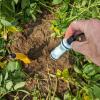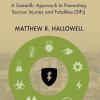Research
 By combining hydrology and paleoclimate modeling, Balaji Rajagopalan, professor of civil engineering, and colleagues uncovered the long-standing mystery behind the disappearance of the Harappan Civilization.
By combining hydrology and paleoclimate modeling, Balaji Rajagopalan, professor of civil engineering, and colleagues uncovered the long-standing mystery behind the disappearance of the Harappan Civilization. Researchers have developed a device that can precisely control laser light using a fraction of the power and space required today. Because it can be manufactured just like modern microchips, this tiny device could unlock quantum computers capable of solving problems far beyond the reach of today’s technologies.
Researchers have developed a device that can precisely control laser light using a fraction of the power and space required today. Because it can be manufactured just like modern microchips, this tiny device could unlock quantum computers capable of solving problems far beyond the reach of today’s technologies. A CU Boulder team has invented a sound-wave technique that softens dense tumors so chemotherapy can penetrate more deeply. The discovery could boost treatment effectiveness and make cancer therapies safer for patients.
A CU Boulder team has invented a sound-wave technique that softens dense tumors so chemotherapy can penetrate more deeply. The discovery could boost treatment effectiveness and make cancer therapies safer for patients. Ulubilge Ulusoy is advancing the science of artificial intelligence to help astronauts on future missions to Mars. Although such a flight is years away, AI systems will be critical to assisting astronauts as they journey beyond Earth’s orbit.
Ulubilge Ulusoy is advancing the science of artificial intelligence to help astronauts on future missions to Mars. Although such a flight is years away, AI systems will be critical to assisting astronauts as they journey beyond Earth’s orbit. PhD student Laura Shannon, alongside Professors Greg Rieker and Peter Hamlington of the Paul M. Rady Department of Mechanical Engineering are setting fires inside wind tunnels to gain a better understanding of how fire spreads across different terrain. The team says their findings could help keep communities safer in a world where climate-driven wildfire is becoming more common—and more dangerous.
PhD student Laura Shannon, alongside Professors Greg Rieker and Peter Hamlington of the Paul M. Rady Department of Mechanical Engineering are setting fires inside wind tunnels to gain a better understanding of how fire spreads across different terrain. The team says their findings could help keep communities safer in a world where climate-driven wildfire is becoming more common—and more dangerous. Elle Stark, a PhD student in the Department of Civil, Environmental and Architectural Engineering, was recently awarded a prestigious Gallery of Fluid Motion (GFM) Award for a video describing her research.
Elle Stark, a PhD student in the Department of Civil, Environmental and Architectural Engineering, was recently awarded a prestigious Gallery of Fluid Motion (GFM) Award for a video describing her research. Chemical and Biological Engineering PhD Student Bruce Kirkpatrick was honored with the 2025 Outstanding Dissertation Award. His hydrogel research supports technologies that enable 3D cell culture for tissue engineering and disease modeling, as well as acellular biomaterials for applications like controlled release of drugs or vaccines.
Chemical and Biological Engineering PhD Student Bruce Kirkpatrick was honored with the 2025 Outstanding Dissertation Award. His hydrogel research supports technologies that enable 3D cell culture for tissue engineering and disease modeling, as well as acellular biomaterials for applications like controlled release of drugs or vaccines. Soil is comprised of an intricate network of bacteria and other microbes that humans depend on, but this complex environmental system is constantly shifting, making it difficult for scientists to measure. Associate Professor Gregory Whiting and his team of researchers are developing reliable, inexpensive and easy-to-deploy sensors that monitor soil in real time to help farmers optimize their use of fertilizers, reduce greenhouse gas emissions and save money in the process.
Soil is comprised of an intricate network of bacteria and other microbes that humans depend on, but this complex environmental system is constantly shifting, making it difficult for scientists to measure. Associate Professor Gregory Whiting and his team of researchers are developing reliable, inexpensive and easy-to-deploy sensors that monitor soil in real time to help farmers optimize their use of fertilizers, reduce greenhouse gas emissions and save money in the process. Assistant Teaching Professor James Harper recently led a behavioral study analyzing toilet use in Cambodia. Their goal was to introduce a new, smart toilet design that can keep rural households safe and protect the environment. But while households reported that they liked the new system, a crucial piece was missing: using it correctly.
Assistant Teaching Professor James Harper recently led a behavioral study analyzing toilet use in Cambodia. Their goal was to introduce a new, smart toilet design that can keep rural households safe and protect the environment. But while households reported that they liked the new system, a crucial piece was missing: using it correctly. With fatalities unchanged for nearly two decades, industry has been hungry for clear, practical guidance rooted in solid research, says Professor Matt Hallowell. In his first book, Hallowell summarized the research of more than 100 journal papers in reader-friendly terms, providing the first comprehensive, evidence-based explanation of why serious worksite injuries persist and how to prevent them.
With fatalities unchanged for nearly two decades, industry has been hungry for clear, practical guidance rooted in solid research, says Professor Matt Hallowell. In his first book, Hallowell summarized the research of more than 100 journal papers in reader-friendly terms, providing the first comprehensive, evidence-based explanation of why serious worksite injuries persist and how to prevent them.

